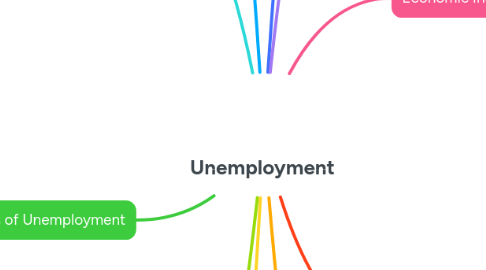
1. When does it occur?
1.1. The no. of workers able and willing to work EXCEEDS the no. of jobs available
1.2. The supply EXCEEDS demand in labour market
2. Official Definition of Unemployment
2.1. **Not in labour force**
2.1.1. Age 15 and below
2.1.2. Housewives, homemakers, discouraged workers, retirees
2.1.3. Those who are not ABLE AND WILLING TO WORK
2.2. Part of labour force (Employed/Unemployed)
2.2.1. Age 15 and above
2.2.2. Actively searching for jobs
2.2.3. ABLE AND WILLING TO WORK
3. Labour Market Equilibrium
3.1. Labour Demand
3.1.1. No. of workers firms are willing and able to hire
3.1.1.1. Non-wage factors affecting Labour Demand • ↑consumer demand for a product = business needs to take on more workers **(shift right)** • AD ↓businesses cut operations costs and scale back on production **(shift left)**
3.2. Labour Supply
3.2.1. No. of workers who are willing and able to work
3.2.1.1. Non-wage factors affecting Labour Supply • Population ↑= S **↑(shift right)** • Changing attitude towards work and more childcare options available = S **↑(shift right)**
3.3. At Equilibrium
3.3.1. Labour Demand = Labour Supply
3.3.2. Workers employed at an equilibrium wage rate
3.3.3. Labour Supply > Labour Demand ↑ Unemployment = Labour Surplus
3.3.4. Labour Demand > Labour Supply = Labour Shortage
3.3.5. Wage rate changes = **movement along labour demand/supply curve or both**
4. Minimum Wage
4.1. Legally mandated price floor on hourly wages
4.2. Minimum wage is usually set above the equilibrium wage
4.3. Wage Rate ↑ = Labour Supply ↑ Labour Demand ↓
4.3.1. Surplus of workers without jobs and thus unemployment.
5. Costs of Unemployment
5.1. Personal
5.1.1. • Loss of income • Loss of skills • Low self esteem • Psychological stress
5.2. Social
5.2.1. • Rising crime rate • Rising suicide rate • Rising divorce rate • Political/social unrest
5.3. Economic
5.3.1. • Underutilizing of resources • Decline in consumption, investment • Loss of income tax revenue
6. Full Employment
6.1. The economy is using all its existing resources to produce at its potential GDP
6.2. Operating at the full employment level = NO cyclical unemployment
6.3. ALWAYS have some frictional and structural unemployment even when the economy is at its full employment
6.4. **At full employment, unemployment rate ≠ 0%) aka the Natural Rate of Unemployment**
7. Reducing Unemployment
7.1. Enhance the availability of Information
7.1.1. Provide platforms which job seekers can find information of vacancy
7.1.1.1. • Career Fairs • Jobs Portal (JobsDB, Monsters) • National Jobs Bank
7.1.1.2. Reduce frictional unemployment
7.2. Jobs Creation
7.2.1. Tax incentives or government grants to attract multi-national companies to set up operations in the country
7.2.1.1. • Increase in government spending • Government subsidy • Tax cuts / incentive
7.3. Improve Employability
7.3.1. Enhance skillset through education and training
7.3.1.1. • Encourage upgrading of skillset (e.g.: Singapore - SkillsFuture credit) • Internship • SkillsFuture Earn and Learn Programme
8. Economic Indicators
8.1. Labour Force Participation Rate
8.1.1. Willingness of people of working age to work
8.1.2. LFPR = Labour Force/Working Age Population x 100
8.2. Unemployment Rate
8.2.1. Non-availability of jobs for people who are able & willing to work
8.2.2. Unemployment Rate = No. of People Unemployed/Labour Force x 100%
9. 4 Types of Unemployment
9.1. **Cyclical Unemployment**
9.1.1. Lack of demand of goods & service during economic slowdown/recession
9.2. **Structural Unemployment**
9.2.1. Mismatch of skills/geographical location
9.3. **Frictional Unemployment**
9.3.1. Search time to find/change jobs (eg. fresh grads/switching jobs for better benefits)
9.4. **Seasonal Unemployment**
9.4.1. Routine changes in the demand of certain kinds of labour (eg. festive period)
